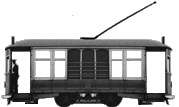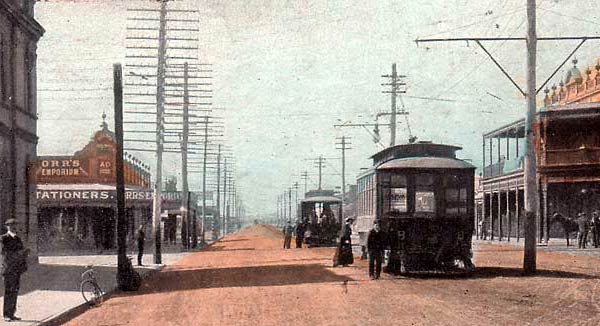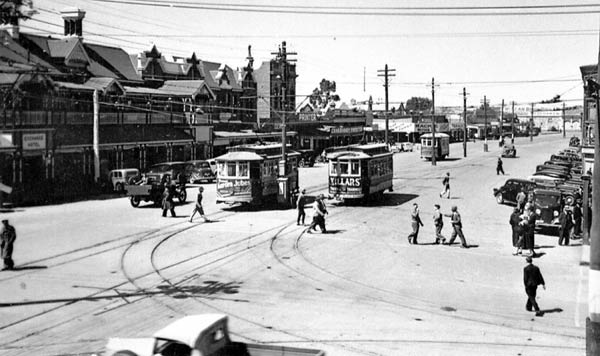Perth Electric Tramway Society
Operator of
Western Australia's Heritage Tramway
Whiteman Park - Perth - Western Australia

Kalgoorlie Tramways
1902 - 1952

Kalgoorlie is situated some 600 kilometres inland from Perth, the capital city of Western Australia. In the 1890s significant gold discoveries were made in the state, notably at Coolgardie and shortly thereafter at nearby Kalgoorlie and its twin city of Boulder: Kalgoorlie-Boulder is the site of the famous "Golden Mile".
After the initial "goldrush" phase, it soon became clear that the Golden Mile contained an enormous amount of gold, which could be extracted by underground mining - leading to the formation of mining companies and a permanent population.
This led to the development of civic infrastructure, suburbs and the need for public transport. Railways and tramways were both to play a part in the public transport system of the area.
The Kalgoorlie Electric Tramways Limited was formed to build and operate tramways in Kalgoorlie and Boulder. This company had close links with the Perth Electric Tramways Limited, but unlike the Perth situation, the Kalgoorlie operation was to remain privately owned for most of its life.

Kalgoorlie trams led by #25, with a full load of passengers, soon after the opening of the system.

Tram 12 with an early form of advertising.
The tramways began operation in May, 1902, and by 1905 the routes ran
- between Kalgoorlie and Boulder via
- Salisbury Rd
- Federal Rd
- Boulder Rd [Boulder Block]
- within Kalgoorlie to
- Outridge Terrace
- Lamington Heights [via Maritana St]
- Collins St
- Kalgoorlie Railway Station
- Hannan St
- Kalgoorlie Racecourse
- South Kalgoorlie
- within Boulder to
- Kamballie
- Fimiston
- Hopkins St
- Boulder Racecourse
The system as planned was at this stage complete, with 14.83 route miles, much of it in double track. This was a large system for the size of the town. By comparison the tramway systems in two other Australian gold towns, Ballarat and Bendigo, were of 13.84 route miles and 8.64 route miles respectively. No further extensions were made or needed to the original routes.
The years when the tramways were planned and built coincided with a time of maximum prosperity for the gold industry, which is dependent on world-wide forces. As the twentieth century unfolded, the fortunes of Kalgoorlie-Boulder and its tramway system fluctuated with the gold industry.
Operating costs were contained by the use of trailer cars - a single power car could have up to four trailers attached to it at shift change times at the mines.
Passenger revenue was supplemented by extensive use of advertising on the trams - always a prominent feature:

At the Carbarn - 1 bogie car and 3 single-truck cars with a consistent advertising theme.
After the 1914-1918 War, many soldiers did not return to the district. Alluvial gold deposits had been worked out, and the many retrenchments caused further population decline. Many houses in the outer suburbs were sold for use on farms, leaving a scattered population. As a result many of the lines to these suburbs, regarded as "branch" lines, were closed, leaving just the core lines within and between the twin towns.
A revival of the gold mining industry about 1930 led to a revival of the tramways. The operating concession was extended by fifteen years, and many trams were renovated, with platforms being enclosed and some bodies being completely dismantled and rebuilt.
However, in 1936 another tram route was closed when it was found to be too expensive to extend the Boulder Block line from Fimiston to Chaffers. Instead a bus service was introduced, also replacing the trams on the Kamballie - Fimiston and Boulder Racecourse tram lines.
After the 1939-45 War, which temporarily brought more life to the town, the need for trams was reduced to peak hours and miners' Specials only. The Kalgoorlie Electric Tramways company was taken over in 1949 by the Eastern Goldfields Transport Board, which closed the system on March 10, 1952.

Trams at the intersection of Hannan and Maritana Streets, Kalgoorlie
Kalgoorlie Tramcars
This table gives some information about the Kalgoorlie tramcar fleet.
| Tramcar numbers |
In service |
Capacity | Description |
|---|---|---|---|
| 1 - 15 | 1902 | 28 seats | Single truck saloon Body: JG Brill, USA |
| 16 - 25 | 1902 | 56 seats | Bogie saloon Body:JG Brill, USA 16-20 sold to Perth, 1903 |
| 16 - 20 [2nd] |
1904 | 28 seats | Single truck saloon Body: JG Brill, USA Replacing original bogie cars 16-20 |
| 1 - 4 | 1930s | 36 seats | Single truck saloon Body: Kalgoorlie Electric Tramways, WA Original cars rebuilt |
| 8 - 9 | 1931 | 56 seats | Twin-coupled saloon Converted: KET, WA Original cars permanently coupled, wired as single 4-motor car. |
| 11 - 12 | 1933 | 75 seats | Single truck saloon Body: KET, WA Original cars rebuilt and lengthened. |
| Trailer numbers |
In service |
Capacity | Description |
| 1 - 2 | 1902 | 40 seats | Open, centre-aisle car. Bodies later enclosed |
| 3 - 7 | 1904 | 36 seats | Single truck saloon |